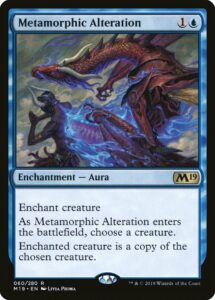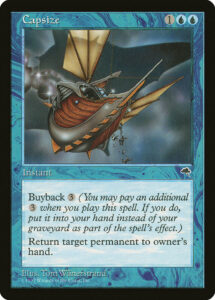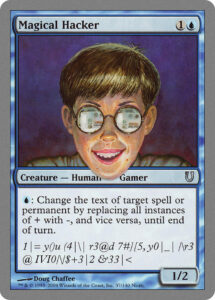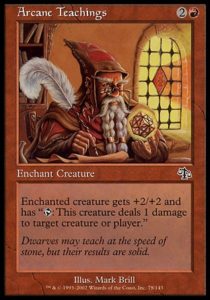As Magic moves into its thirtieth year and Hipsters celebrates its tenth anniversary, now is a perfect time to reflect on some of Magic’s biggest changes over the past decade. Magic is a hungry monster that constantly needs innovation to survive and cater to an ever-changing array of audiences. At the same time, the game remains firmly anchored to its past, where cards all the back to Alpha remain compatible with the newest cards. Balancing those two foundational needs, innovation and familiarity, is essential to Magic’s survival up to and thriving in the present day. And there has been a lot of innovation since 2013.

No more blocks
The first decade of Magic’s design saw the birth of block structure, where multiple expansions were planned around specific themes and locations. The format was rigid: one large set followed by two small sets. Magic’s second decade saw this paradigm toyed with, from Ravnica’s splitting color pairs among the block rather than within each set, to Shadowmoor and Rise of the Eldrazi tweaking it, to Coldsnap breaking it entirely.
This past decade, block structure continued to cause issues—diminished interest in, satisfaction with, and sales of the small sets—leading Wizards of the coast to shrink blocks to just two sets in 2015. Three years later, they eliminated blocks altogether in 2018. If you’ve started playing in the past four and a half years, you have never played during a block. And that’s okay—they went away for strong reasons.
This decade presents new challenges. Magic is still trying to get annual balance right. Most Magic stories are compressed into a very tight, one act window. Now that mechanics are rarely featured more than once a year, cross-set synergy is harder to come by. It’s very easy for Standard to get defined by a single set, and for non-rotating formats to receive only a small number of synergistic mechanics like Lessons and Foretell. That brings us to another massive change.

The Rise of Commander and Fall of Standard
Perhaps the biggest change on the player side of Magic is how people play the game. For most of Magic’s existence, Standard was the most commonly played form of sanctioned Constructed (the vast majority of play is the very casual format, “Cards I Own”). This made sense for both Magic: The Gathering and its players. Having cards rotate out of playability means that new cards don’t need to compete with every card ever made.
Wizards can sell new cards without them needing to outclass Black Lotus (a problem known as power creep) or by maintaining a massive ban list. Players have to deal with rotation (which means they can’t keep playing with the same cards over time), but every card they need is in print—there are no cards in short supply. Now, I’ve never been much of a Standard player (Limited is by far my favorite way to play), but it makes for a dynamic format that changes regularly.
The period of 2016-2020 was deeply damaging to Standard, with at least four cards being banned every year. The (temporary) death of the Pro Tour and the massive disruption of the pandemic did not help matters (though it being the primary Constructed format on Arena certainly bolstered it). Meanwhile, Commander (a player-created format) exploded in popularity over the past decade. Commander received its first preconstructed deck way back in 2011, and by late 2019 it had surpassed Standard as the most popular Constructed format, with every Standard expansion being accompanied by a Commander release.
In the next decade, the sustainability of this shift is a big question. In refocusing the game around non-rotating Constructed, Wizards once more has to deal with the same issues it encountered in the ’90s. Can they sustain sales without rampant power creep? How does engagement work when formats are less dynamic over time and play is more casual? Can they reprint enough cards fast enough? There are also Commander-specific challenges, such as not designing must-plays like Sol Ring, Arcane Signet, and Commander Tower that essentially all Commander decks are incentivized to play.

Modes of play
In the last section, we discussed changes to formats and how that affects play. But the platform is also of paramount importance and has seen far more shifts.
In 2013, there were three main ways to play Magic. The vast majority of play was tabletop Magic, with some digital play via Magic Online and Duels of the Planeswalkers. In 2022, far more Magic is digital. The creation of Magic Arena has been a game-changer for bringing in new and lapsed players, given players more ways to engage with the game, and been a boon during the pandemic. Moreover, Magic is embracing digital affordances via Alchemy—it’s worth discussing at length another day, but the game has always embraced tabletop-only affordances through products like Unstable and Conspiracy. Digital has made Magic bigger, and it has changed the nature of how Magic is made and played. And that’s not even mentioning the effects of Spelltable or Magic’s reinvigorated focus on making new digital games.
At the same time, there are more ways that Magic is packaged than ever before. Wizards has experimented with new product lines throughout Magic’s life, but the creation of Booster Fun, Secret Lairs and both Collector and Set Boosters have changed the way that people buy and collect Magic cards. There are more ways than ever to customize decks, more avenues than ever to reprint cards, and less pressure for non-premium cards to be expensive.
These changes, perhaps more than any other, have brought Magic more profits and success in the past few years than it has ever seen before. I’m curious how sustainable this growth will be—as mentioned in the last section, it’s very hard finding the right balance with power creep for non-rotating formats, but growth is predicated on more people playing wanting more cards.
Looking ahead, there’s a lot to be excited about. Magic is continuing to expand its options and its audiences. Not all experiments will be successful, and some players will feel left out by products not intended for them or by the game shifting focus away from what they care about the most. But as expressed at the beginning, Magic needs to innovate to survive, and it has been thriving as of late.

I’d argue those were the biggest of the big changes over the past decade, but it still glosses over plenty of changes that were merely monumental instead of game-changing. There was the creation of Pioneer. The death (and continuing rebirth) of the Pro Tour and organized play. The creation of Play Design and Studio X. The announcement of F.I.R.E. design (a paradigm that’s probably just as misunderstood and unfairly maligned as New World Order was the prior decade). The continual rebalancing of Limited, first with weakened removal and stronger creatures from 2012-2018, then a shifting towards more power and complexity at common ever since. The dramatic increase in wordiness and card complexity (as well as the removal of vanilla creatures). The birth and death of Planeswalker decks, Signature Spellbooks, Modern Masters, Battlebond, and Conspiracy, plus the death, rebirth, and death of Core Sets. The creation of mainstay modern mechanics like Vehicles and Sagas, and mainstay products like Modern Horizons.
In short, it has been a deeply consequential decade. That’s hardly a surprise, given how enormous an achievement it is for a game to last close to a decade, yet Magic is still wildly popular as it moves into its fourth decade. Here’s looking forward to seeing all that comes during it—the things that are meant for me and those that aren’t; the experiments that hit the mark and those that don’t but teach great lessons, and of course, all the draft formats. And, as always, thanks for reading.
Zachary Barash is a New York City-based game designer and the last commissioner of Team Draft League. He designs for Kingdom Death: Monster, has a Game Design MFA from the NYU Game Center, and does freelance game design. When the stars align, he streams Magic (but the stars align way less often than he’d like).

